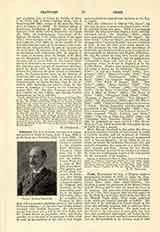

Crawford, FRANCIS MARION, novelist, b. of American parents at Bagni di Lucca, Italy, August 2, 1854; d. at his home near Sorrento, Italy, April 9, 1909. In early manhood he became a convert to the Catholic Faith. His father, Thomas Crawford, was a distinguished sculptor; his mother, Louisa Ward, was a sister of Mrs. Julia Ward Howe. The greater part of his youth was passed at Rome, and, after having studied in various colleges in America, England, and Germany, he terminated his studies in the Roman University, where he attended the lectures in Sanskrit and comparative philology given by the learned Professor Lignana. At the same time he was already occupied with English literature. He afterwards passed four years and a half in the East Indies and the United States as journalist, critic, and finally novelist, up to the time of his marriage in 1884, when be took up his residence at the villa he had bought and remodeled for himself near Sorrento on the Bay of Naples.
With the publication in 1882 of “Mr. Isaacs”, his first and in some respects most characteristic novel, he suddenly leaped into fame. While it was running through the press Crawford began a more carefully composed novel, “Dr. Claudius” (1883), which more than repeated the success of “Mr. Isaacs”. His third novel, “A Roman Singer”, ran serially through the pages of the “Atlantic Monthly” and was published in 1884. It was this third novel which opened out to Mr. Crawford his true field, the description of Italian life and character with its many cosmopolitan, and especially its American and English, affiliations. He was the author of some forty novels and one play, “Francesca da Rimini”, and his publications commanded a larger sale than those of any contemporary writer of fiction in England or in the United States. Besides those mentioned his principal works of fiction are the following: “Zoroaster” (1885); “A Tale of a Lonely Parish” (1886); “Saracinesca” (1887); “Marzio’s Crucifix” (1887); “Paul Patoff” (1887); “Greifenstein” (1889); “Sant’ Ilario” (1889); “A Cigarette Maker’s Romance” (1890); “The Witch of Prague” (1891); “Don Orsino” (1892); “Pietro Ghisleri” (1893); “The Ralstons” (1895); “Corleone” (1897); “Via Crucis” (1899); “In the Palace of the King” (1900); “Marietta, A Maid of Venice” (1901);- “The Heart of Rome” (1903); “Whosoever Shall Offend” (1904); “Soprano, A Portrait” (1905); “Fair Margaret” (1905); “The Primadonna” (1907); and “The Diva’s Ruby” (1908). Crawford did not confine his attention to fiction. History, biography, and description are represented in his: “Constantinople” (1895); “Ave, Roma Immortalis” (1898); “The Rulers of the South” (1900) renamed “Sicily, Calabria and Malta” (1904); “The Life of Pope Leo XIII” (1904); and “Gleanings from Venetian History” (1905). In 1904 he published an essay entitled “The Novel: What it is”, in which he gives his views upon the art of which he was a master.
While Marion Crawford in his public life always professed himself a Catholic, he can scarcely be called a Catholic novelist, and his treatment of Catholic subjects in several of his works does not recommend itself to his coreligionists. In his Philip II, for example, he follows the traditional Protestant view and unjustly represents that monarch as a brutal bully, cruel, sensual, and base. During his last illness, Marion Crawford received all the comforts of religion. He chose the neighboring chapel of the Franciscans for the ceremonies of his requiem.
E. P. SPILLANE

